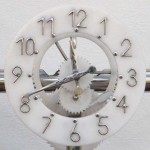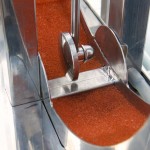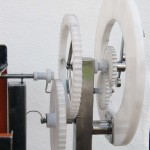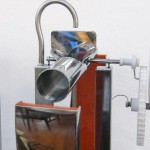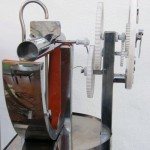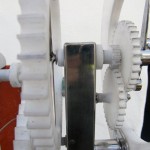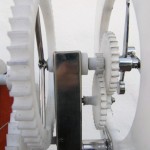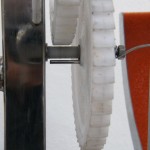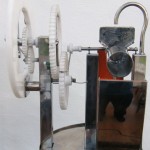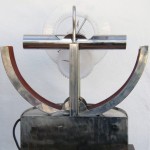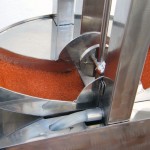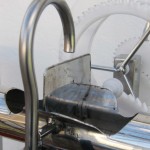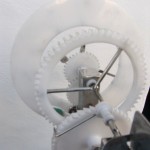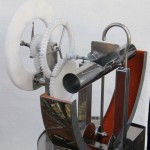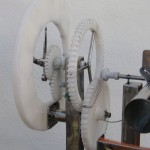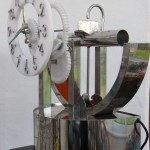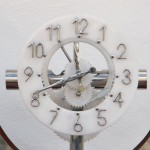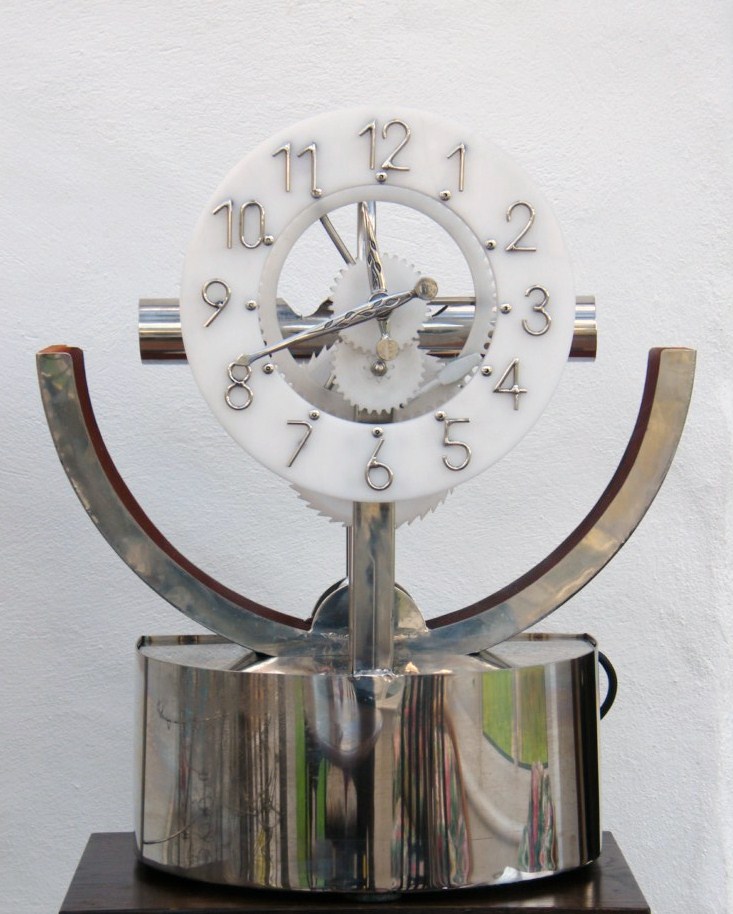
Designed and built as a one-off by Nigel Loller.
Constructed from welded stainless steel and acetal.
The clock is designed to be placed on a table or stand, and can be placed with its back to a wall. It may also be used outdoors.
Description — Photos — Videos
General description of the clock:
My own unique design Pendulum Driven Clock, driven by the weight of the water landing in the ‘cross’ tube of the pendulum assembly, which is divided by a baffle.
As the pendulum swings, the water is forced to flow into one side then the other… the resulting movement then powers the clock by means of the escapement (ratchet) wheel.
All white parts are machined from acetal; the gears are hand cut on my band saw and ‘broached’ where needed with pillar drill (drill press).
All shiny parts are stainless steel, welded with my ‘RTECH 200’ tig.
The Clock ‘ticks’ at 46 beats per minute and therefore the escapement wheel has 46 teeth… from there on it is simple to gear the minutes and hours.
Apart from the obvious water power (small pond pump in base), the other unique thing is the drive from the escapement to the minute (60 tooth) wheel is by effectively a one tooth gear, having a single peg which only engages once per revolution and does away with one complete 60 to 1 gear train.
Fine adjustment is via a bob weight at the bottom of the pendulum and works opposite to convention, i.e. up is slower and down is faster (due to the amount of time the water has to escape the tube)
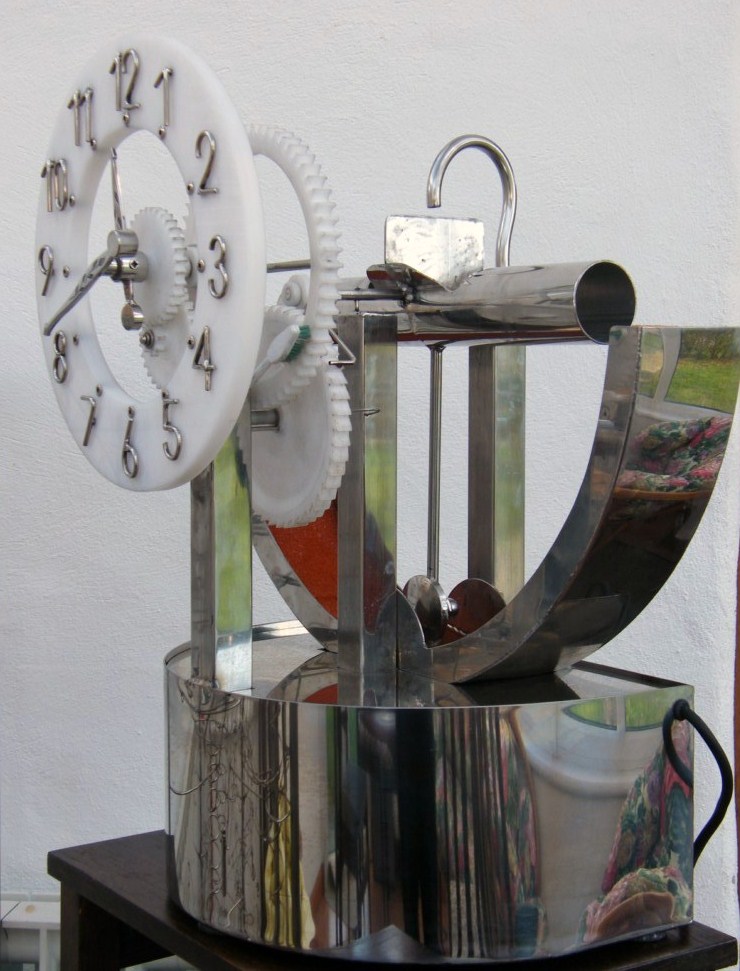
Potential customers / uses / locations :
- Private house / conservatory / garden
- Technology exhibition or museum
- Events organisers
- Garden centres
- Large hotels
- Public areas such as airports or harbours
- Waiting areas
- Shopping Mall or shop window display
- Educational touring piece, for school visits or careers or crafts exhibitions
The machine is currently on display at Paints the Jewellers in St Peter Port, Guernsey (As of 20th October 2011).
Dimensions :
As shown with water tank and water collector :
- overall height 55.5 cm;
- overall width 49.5 cm;
- overall depth 35 cm.
Without the water tank and water collector (for installation over a pond or other water source) :
- overall height 43.5 cm;
- overall width 35 cm;
- overall depth 35 cm.
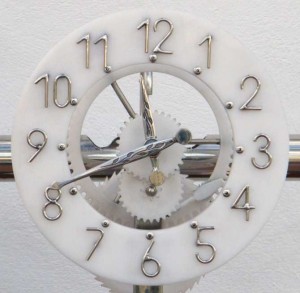
Interesting facts :
- 100 hours design and build time
- Two fork handles were used to form the “hands” of the clock
- Many unique design and mechanical features
Installation
The clock has been built with a base tank to contain the water and pump, and a semi-circular water collector, allowing it to be used as a standalone item, needing only an electricity supply.
However the clock may instead be installed over a pond or other water source, without the tank or collector.
The water pump is mains powered (220-240V) but a different pump or water supply could be substituted.
The clock may be used indoors or outdoors.
Quantity available :
This is a one-off design but could be repeated or modified to your requirements.
Questions
Any questions, please ask.
Buy
Would you like to buy this item? Contact us for price and delivery estimate.
Description — Photos — Videos
Photos
Description — Photos — Videos
Videos
(transcript below)
Transcript of video commentary :
“This is my new project which is now finished and working well. It’s a unique, water powered pendulum clock.
“The power for the whole motion comes from the pendulum which is working a walking type of escapement / ratchet, but the pendulum is powered by water which is pumped up from the tank below, there, you can see with the lid on it; and it is caught in the semi circular shaped channel with the filter foam in it, which catches any extra splashes so it’s perfectly dry. The movement itself is made from acetal (machine plastic); all the frame and the rest of the clock is stainless steel so it could live outside.
It’s especially unusual as far as I know because the escapement / ratchet wheel engages the minute hand wheel just once every minute. You can see there is a peg, which only engages the 60 tooth gear literally once every revolution, so once per minute, and therefore the rest of the clock isn’t moving at all, until that peg which you can just see clearing daylight now comes round to engage that gear. And then the hour hand is driven with the set of gears that you can see at the front at 12 to 1.
“And there it is – beautiful movement. It’s running on a very small water pump within the base tank – a garden pond pump which should last for years. It’s got something like 5 moving parts, so really one of the most simple clocks you could ever build, and it’s all built on fairly basic machine tools, obviously with a lot of 316 stainless steel and a fair amount of welding involved, but all the gears are hand cut.”
Description — Photos — Videos
